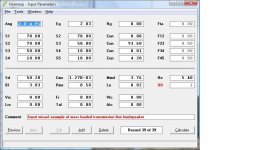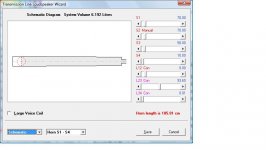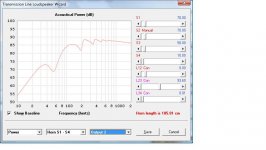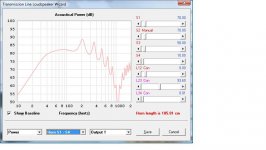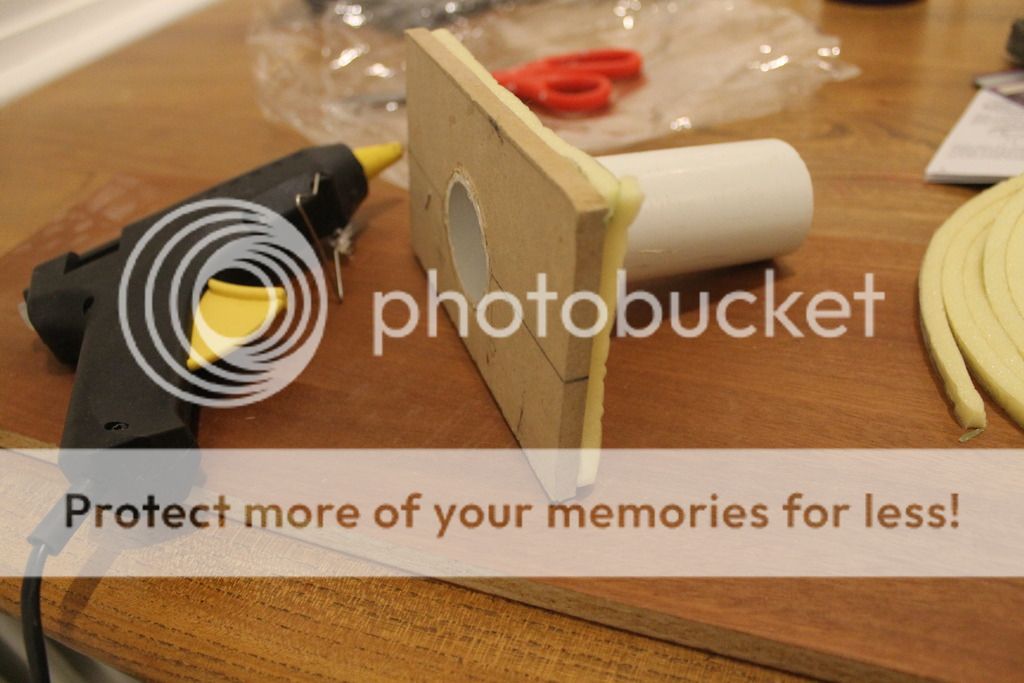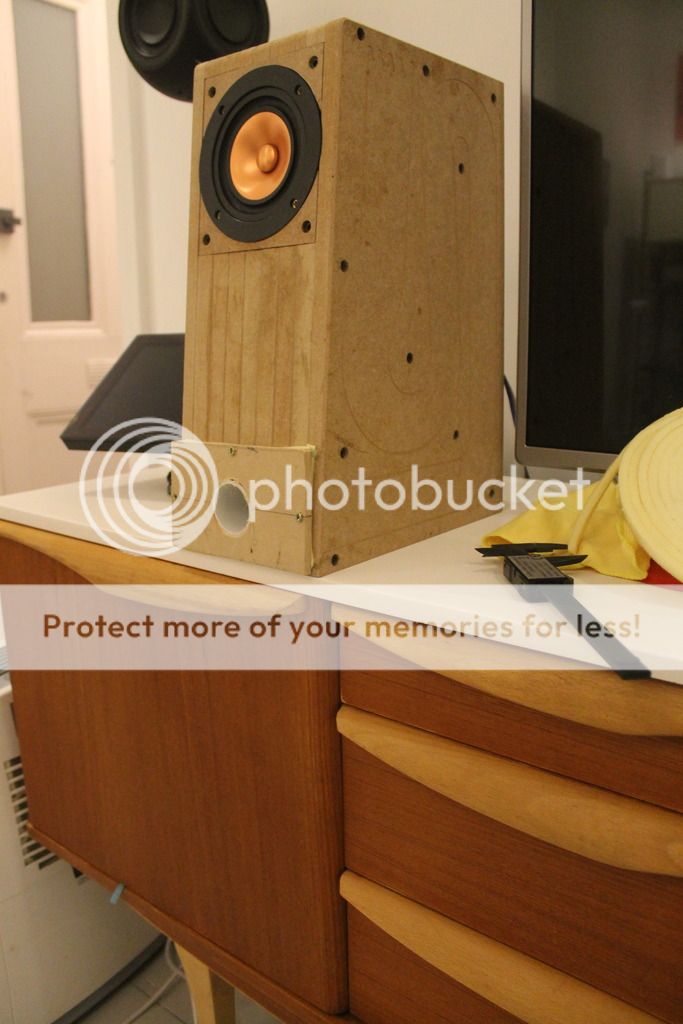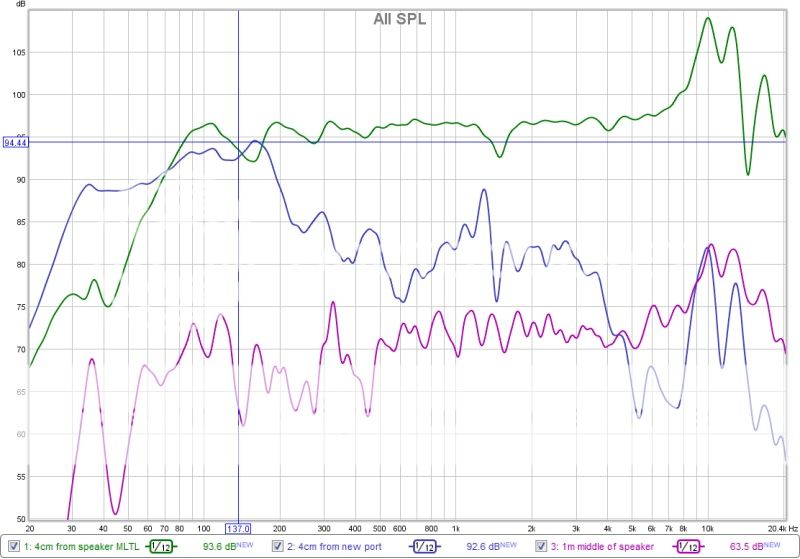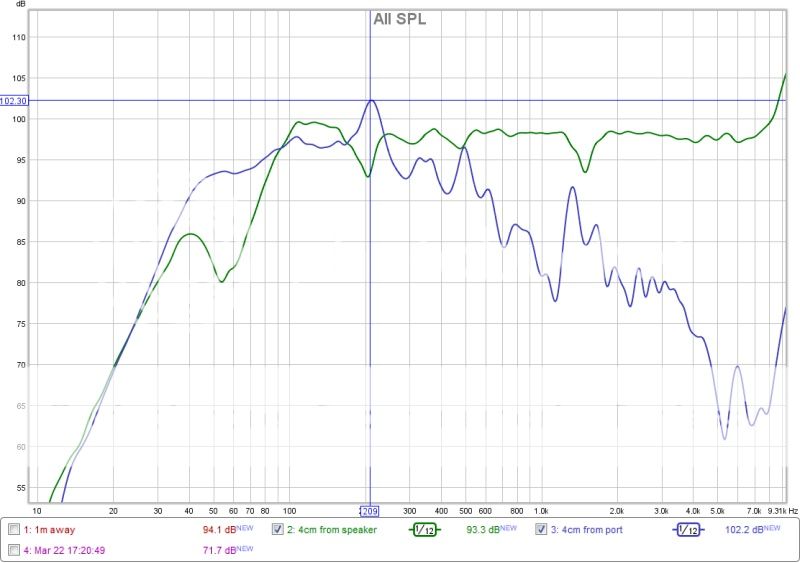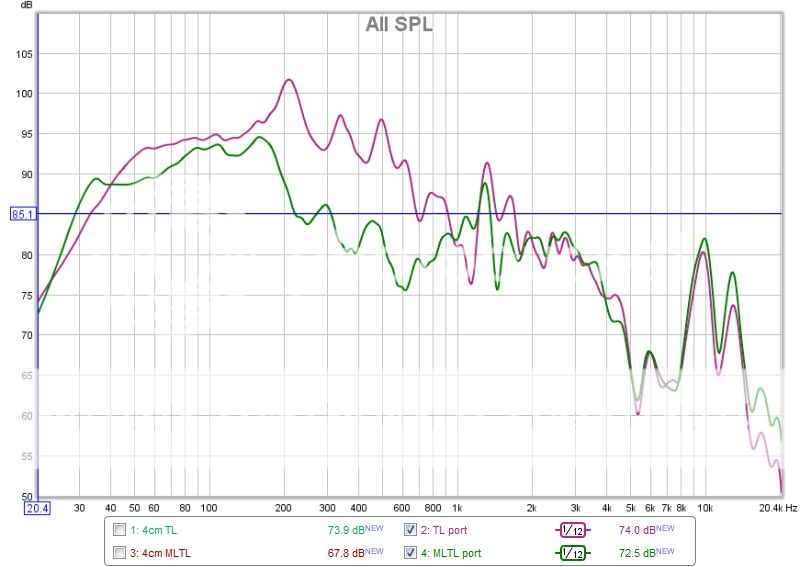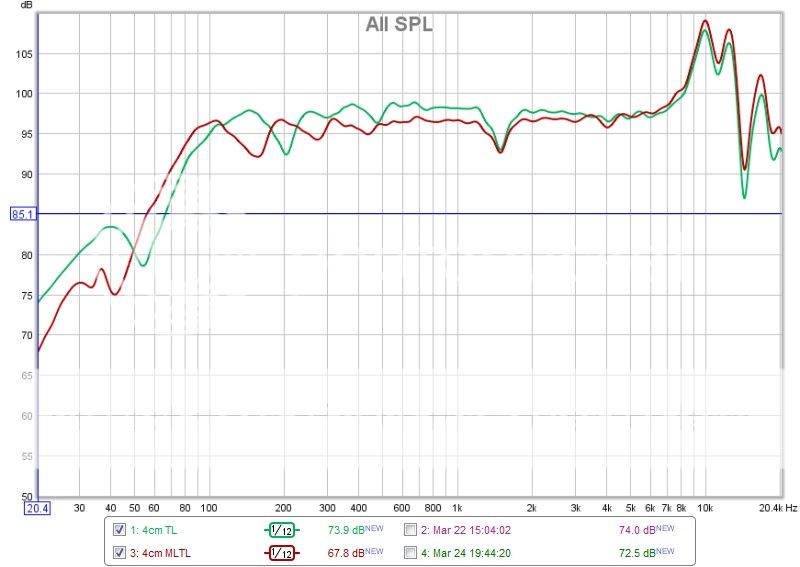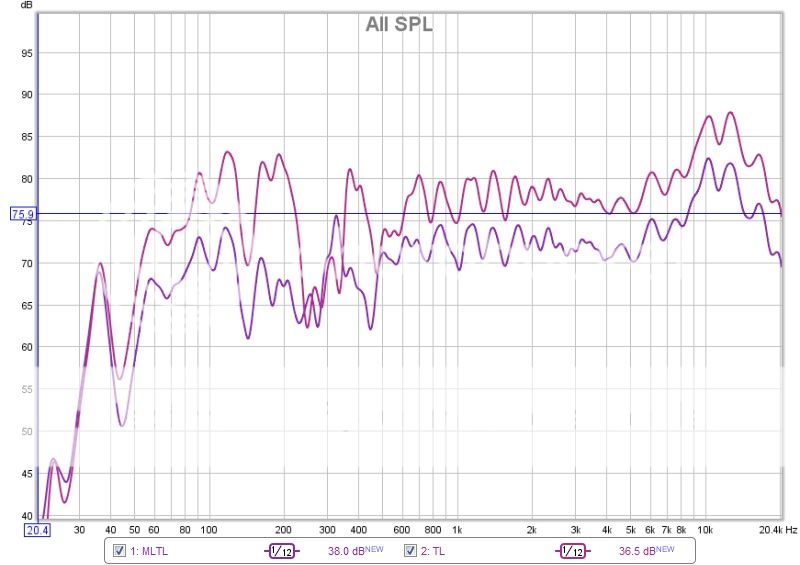The pics below show a long BR with the driver output, port output and combined output.
For what it's worth, adding a port to a transmission line makes it mass-loaded, so we've got an ML-TL in your simulations, which is a quarter-wave resonator.
Helmholtz (half-wave) resonators (ported boxes) need to be more cube-like in their aspect ratio, or they'll enter the transmission line area as we have here.
My suggestion would've been to use the port exit and the section that goes up the back, having removed most of the rest of the internals. Probably gives a 5L box with a fairly low tuning, likely to sit better with most rooms' tendency to add gain in the LF.
Chris
Agreed, a long path behind the driver can setup standing waves as well. May have to add some damping. It was a suggestion to attempt a "different" sound without permanently changing the box.For what it's worth, adding a port to a transmission line makes it mass-loaded, so we've got an ML-TL in your simulations, which is a quarter-wave resonator.
Helmholtz (half-wave) resonators (ported boxes) need to be more cube-like in their aspect ratio, or they'll enter the transmission line area as we have here.
My suggestion would've been to use the port exit and the section that goes up the back, having removed most of the rest of the internals. Probably gives a 5L box with a fairly low tuning, likely to sit better with most rooms' tendency to add gain in the LF.
Chris
I'll add another for "closed box" min volume by jamming a block of styrofoam in the TL midpath.
I like the idea of converting to an ML-TL. It's most of the way to the performance of a ported box (which, IMO, would only improve things because it'd increase the effective cabinet volume) without any woodwork.
The port at the end of an ML-TL helps a little with the harmonics, since it puts a bandpass on there. Might not need much stuffing, though I'd always recommend an irregular shape around the driver where possible to break up reflections back through the cone.
Chris
The port at the end of an ML-TL helps a little with the harmonics, since it puts a bandpass on there. Might not need much stuffing, though I'd always recommend an irregular shape around the driver where possible to break up reflections back through the cone.
Chris
Here's what the ML-TL looks like. Similar with harmonics. Shorter pipe required. Some damping is required.I like the idea of converting to an ML-TL. It's most of the way to the performance of a ported box (which, IMO, would only improve things because it'd increase the effective cabinet volume) without any woodwork.
The port at the end of an ML-TL helps a little with the harmonics, since it puts a bandpass on there. Might not need much stuffing, though I'd always recommend an irregular shape around the driver where possible to break up reflections back through the cone.
Chris
Attachments
I think this breaks the HornResp model for a BR due to its aspect ratio (boxish vs long tube). As Chris661 correctly points out, the shape is really an ML-TL, so I included that one as well, perf is similar but has harmonics in it which is probably more reality.A comment came up earlier about making it into a Bass Reflex. Hmm,... wonder if that's possible. Well it turns out you can. The entire internal volume of your TL is 7.1L (5x13x110cm), that's enough volume with the right port. The right port is 3.6cm dia x 12cm at the end of the TL.
Take a block of styrofoam (don't scratch the wood) and make it a tight fit (jammed) in the mouth of the TL. Then place the pipe (3.6cm dia x 12cm) in the center of that styro block, assuming you've already made a hole for it. If you suspect air leaks use painters tape (green or blue) to seal the pipe and edges of the styro. Presto, you can test (ugh!) and compare the sound to a TL without commitment. Notice, the saw is still in the case. 😱
The pics below show a long BR with the driver output, port output and combined output.
Thanks Don and Chris
You have given me a great deal to think, read and learn about so bare with me while i go through all the new information.
So its decided i'm turning into an ML-TL and giving it a go!
Don ill PM you!
You have given me a great deal to think, read and learn about so bare with me while i go through all the new information.
So its decided i'm turning into an ML-TL and giving it a go!
Don ill PM you!
Last edited:
Just to repeat myself again, don't overlook that while driver location has less significance in a sealed or theoretically "simple" BR enclosure - i.e. one with relatively low aspect ratio of CSA to length/ height, and ignoring what happens below tuning frequency - in an MLTL, the offset from sealed end is a major factor in the system tuning and control of the harmonics .
See for example the mounting location in Scott's Pensil for this driver.
I think that restricting the area of the terminus, or adjusting the location and density of damping in attempts to turn this enclosure into an MLTL will only go so far in improving its performance. If the objective is for "best compromise" of performance and minimal size enclosure, I'd opine that either of the two simple BR plans would easily deliver better performance.
https://www.madisoundspeakerstore.com/pdf/markaudio-enclosure-plans/Alpair7-BR-nocover.pdf
https://www.madisoundspeakerstore.com/pdf/markaudio-enclosure-plans/Alpair7-GR-nocover.pdf
There are, of course larger or more elaborate designs, some of which I've already mentioned.
See for example the mounting location in Scott's Pensil for this driver.
I think that restricting the area of the terminus, or adjusting the location and density of damping in attempts to turn this enclosure into an MLTL will only go so far in improving its performance. If the objective is for "best compromise" of performance and minimal size enclosure, I'd opine that either of the two simple BR plans would easily deliver better performance.
https://www.madisoundspeakerstore.com/pdf/markaudio-enclosure-plans/Alpair7-BR-nocover.pdf
https://www.madisoundspeakerstore.com/pdf/markaudio-enclosure-plans/Alpair7-GR-nocover.pdf
There are, of course larger or more elaborate designs, some of which I've already mentioned.
More importantly, does it sound different? or better?Yeah, he always likes to keep us hanging in.................suspense.........
Different, yes, better that's what measuring is about? One of these days I may go farther down that road. My measuring is very basic, as I think you already know? Can't remember
What about at 1m position B, combined response?
Thats on the graph Don
More importantly, does it sound different? or better?
It does sound different, unfortunately cant test them to their new abilities
1. Neighbours 2. The wife complaining its too loud (just got back form work).
Ill be able to test them tomorrow and i will let you know.
Thats on the graph Don
Not on the second one for ease and laziness of comparison 😀
OK I got it now, the font is kinda small for me on this laptop. I need to expand the pics.It does sound different, unfortunately cant test them to their new abilities
1. Neighbours 2. The wife complaining its too loud (just got back form work).
Ill be able to test them tomorrow and i will let you know.
Looks like you lost a little of the bottom end LF. Notice that from >200Hz the cabinet changes made no difference in the measurements.
Personally, I liked the before "garden snail" look. Now it looks like it took up smoking. I'd be interested in which one you prefer.
Notice that from >200Hz the cabinet changes made no difference in the measurements.
Are we looking at the same graphs?!
There's clearly a huge drop in output from the port above 100Hz with the ML-TL adapter in place.
The bass tuning also appears to have gone down half an octave.
Chris
- Home
- Loudspeakers
- Full Range
- Transmission Line Speaker Build using Alpair 7.3 speakers, first build.
